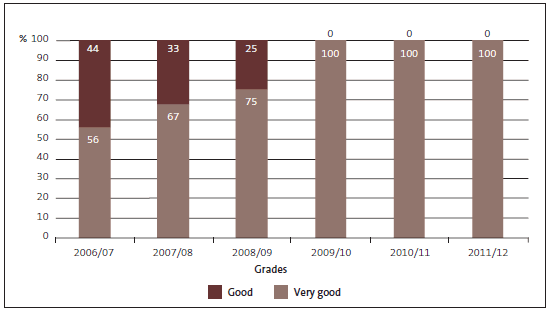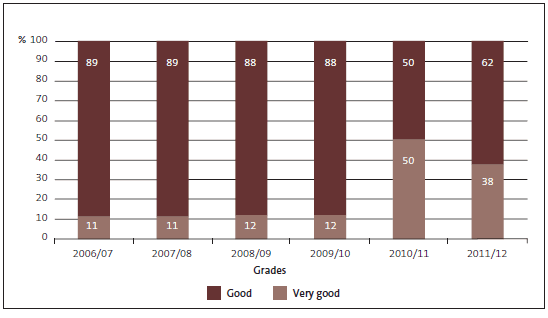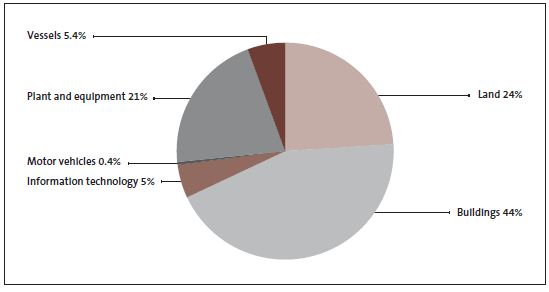Part 2: Audit results for 2011/12
2.1
In this Part, we report on the audit results for CRIs for 2011/12, including:
- our audit opinions;
- our evaluation of CRIs' systems and controls;
- matters of significance we raised in the context of the annual audit; and
- our surveys of CRIs' insurance and asset management.
Audit opinions
2.2
We issued standard unmodified audit opinions for seven of the CRIs for 2011/12.
2.3
For IRL, we issued an unmodified opinion for 2011/12. However, we noted the proposal for IRL to become a subsidiary of another entity.9 We also noted that, although IRL might be disestablished, there was no time frame for this to occur. This event had been disclosed in the financial statements, and we added comment on this in our audit report to highlight that uncertainty to the reader.
Systems and controls
2.4
We assessed that the systems and controls of CRIs were of a high standard.
2.5
As part of the annual audits, our appointed auditors assess and grade the management control environment of CRIs and their financial (but not their service performance) information systems and controls. We report our assessments of each CRI to its management and Board, the Minister of Science and Innovation, MBIE (as the monitoring department), and the Treasury.
2.6
In 2011/12, all eight CRIs were graded as having either "Very good" or "Good" management control environments and financial information systems and controls. A "Very good" grade means that the appointed auditor did not recommend any improvements. A "Good" grade indicates that we do not have any significant concerns but that the appointed auditor recommended improvements that would be beneficial.
2.7
Figure 1 shows a summary of the grades for 2011/12. Our appointed auditors' assessments for 2011/12 continue to show strong performance by CRIs.
Figure 1
Summary of Crown research institutes' grades for 2011/12
| Management control environment | Financial information systems and controls | |
|---|---|---|
| Very good | 8 | 3 |
| Good | 0 | 5 |
| Needs improvement | 0 | 0 |
| Poor | 0 | 0 |
Management control environment
2.8
We graded all eight CRIs' management control environments as "Very good" in 2011/12, continuing the trend of the previous two years. The grades for CRIs' management control environments since 2006/07 have all been either "Very good" or "Good", with a steady improvement to 100% "Very good".
2.9
Figure 2 shows the grades for the management control environment since 2006/07.
Figure 2
Grades for Crown research institutes' management control environment, 2006/07 to 2011/12

Financial information systems
2.10
The grades for CRIs' financial systems and controls since 2006/07 have also all been either "Very good" or "Good". Three of the eight CRIs were graded as "Very good" in 2011/12, compared with four in 2010/11 and one in 2009/10. The CRIs that improved their grades from "Good" to "Very good" in the last two years responded fully to our recommendations for improvement in the previous year.
2.11
Those CRIs that continue to be graded as "Good" responded in part to our recommendations for improvement.
2.12
Figure 3 shows the grades for CRIs' financial information systems and controls since 2006/07.
Figure 3
Grades for Crown research institutes' financial information systems and controls, 2006/07 to 2011/12

Matters of significance
2.13
We noted the following matters in particular CRIs during the 2011/12 audits. In each instance, we discussed the matters with the CRI's Board and management, and reported them to the Minister and to the monitoring department.
2.14
We will discuss with the monitoring department how CRIs manage their projects and assets and operate their core funding agreement, to determine whether there is any relevant guidance and support from MBIE that might be helpful to the CRIs.
Revenue recognition
2.15
Project accounting continues to be an area where there is subjectivity in recognising revenue. We noted improvements in this area in one CRI and changes to project management structure in another. In a third CRI, we identified two contracts where an additional loss should have been recognised in keeping with the relevant accounting standard. The net effect of these was small ($165,000) and has not been adjusted for.
2.16
We noted that four CRIs had deferred some of their core funding. One of the four received its core funding as usual but also received $5 million that was specifically tagged for development in Christchurch. Because this funding was for a specific purpose rather than for the general objectives of the business, the CRI and MBIE agreed that it should be deferred and recognised in line with the expenditure on that specific purpose.10 We discussed the funding deferrals with the monitoring department and understand that the timing of the CRIs' use of funds is influenced by the nature of their science/research projects.
Refurbishment/renewal of assets and asset management planning developments
2.17
We noted refurbishment/renewal of assets and/or major asset plan development in three CRIs.
Valuation of heritage assets
2.18
Two CRIs disclosed their heritage assets in the financial statements as assets that cannot be reliably valued because of their unique and irreplaceable nature.11 One of the CRIs did not revalue two of its three heritage assets for this reason. The other could not reliably value any of its four heritage assets. This is an issue for all CRIs with heritage assets.12 CRIs receive some of their core funding to apply to the upkeep of these assets.
Business restructuring
2.19
The operations of two CRIs were noted as having been affected by the acquisition/disposal of subsidiary businesses. By acquiring a subsidiary, one CRI had acquired existing customer contracts and their associated future revenue streams. For the other CRI, the sale of a subsidiary contributed to lower revenues and expenses compared to budget for 2011/12. The same CRI has provided for impairment to, and is seeking to recapitalise, a poorer performing part of its business and has undergone internal company restructuring.13
Effects of the Canterbury earthquakes on operations
2.20
The operations of two CRIs were noted as having been affected by the Canterbury earthquakes because of minor damage and/or earthquake-related insurance matters.
Poorer financial performance
2.21
We noted a considerable decrease in science revenue in one CRI, with loss of revenue from a subsidiary following restructuring (see paragraph 2.19). Commercial revenue for this CRI was $1 million less than in 2010/11.
Insurance of assets by Crown research institutes
2.22
The theme for the Auditor-General's work programme in 2012/13 is Our future needs – is the public sector ready? As part of this theme, we carried out some work on public entities' insurance of property, plant, and equipment assets, to help show how well insured the public sector is. The information helps in considering the risk that those assets will not be available to deliver services to meet future needs. We asked our auditors of all CRIs for some information about insurance of CRI assets.
2.23
There are eight CRIs, and the total value of their property, plant, and equipment assets as at 30 June 2012 was about $500 million. Most of these assets, apart from land, are currently subject to some form of insurance.
2.24
The main insurance contract for six of the eight CRIs14 is a collective insurance programme that includes a common approach to insuring risk. The property insurance element covers a large range of asset types for the CRIs. The collective is based on a maximum foreseeable loss limit of $150 million for each loss, with automatic reinstatement of limits after a loss. The loss limit is less than the total value of assets covered by the collective that might possibly be at risk. Such an approach is common where there is a reasonable spread of risk.
2.25
As well as the $500 million of property, plant, and equipment assets, a number of CRIs have heritage collection assets, the value of which is not recorded in their financial statements because it cannot be assessed with enough reliability.
2.26
None of these heritage collection assets are insured. CRIs told our auditors that either they were unable to get insurance for these asset types or it was too expensive to do so.
2.27
Also, one CRI has chosen to "self-insure" information technology and other specialist equipment, and another has chosen to "self-insure" its biological assets. Where assets are self-insured, the CRI has the capacity to fund the repair or replacement of such assets, if necessary.
2.28
Most CRIs have experienced a significant increase in insurance premiums since 2010/11. Four of the eight CRIs identified that insurance premiums had more than doubled. Three of the eight CRIs also noted an increase in their insurance excess, and one noted further policy exclusions compared with the previous year.
2.29
When asked about 2012/13, most CRIs expect a further significant increase in their insurance premium. Others expect further policy exclusions or a further increase in their insurance excess.
2.30
We plan to report for all the public entities surveyed on the extent of insurance cover in place for property, plant, and equipment and the extent to which there have been changes in such cover in the past two years. The full report will be published later in 2013.
Asset management in Crown research institutes
2.31
In 2011/12, we also looked at asset management in the public sector. As a further contribution to the Office's theme for 2012/13, the Auditor-General wanted to find out more about, and report on, the management of significant physical assets throughout much of the public sector. This included the condition of significant assets, how well maintained they are, whether enough is being spent to renew them, and the adequacy of checking and reporting on those assets.
2.32
We received returns from about 350 public entities, including all the CRIs. The focus was on assets that are significant to the delivery of services.
2.33
There is more than $220 billion of property, plant, and equipment (excluding intangible assets) in the public sector, of which about $500 million is held by CRIs. Nearly all CRI assets are considered significant. They are largely made up of buildings, land, and plant and equipment. Figure 4 sets out the proportion of significant asset types held by CRIs, by value.
2.34
In 2011/12, about $60 million was spent on assets. This equates to 12% of the total assets held by CRIs. We are currently analysing whether the condition and levels of maintenance or renewals in CRIs are consistent with other areas of the public sector, and will cover this in a separate report to Parliament.
Figure 4
Proportion of significant Crown research institute asset types, by value

Note: Percentages do not add to 100 because of rounding.
9: That other entity was to be known as the Advanced Technology Institute, but was instead called Callaghan Innovation in recognition of the work of the late Sir Paul Callaghan.
10: Core funding is discussed further in Part 4.
11: An example is Scion's germplasm collection.
12: In our view, it is preferable to have heritage assets recorded at their deemed cost in the financial statements than not at all. However, this presupposes that the entity knows what heritage assets it has and that such assets can be reliably measured. If reliable measurement of value is not possible, we encourage the entity to disclose the nature and extent of such assets.
13: We comment in Part 3 on the potential resilience of the CRIs.
14: AsureQuality is also in the collective insurance programme.
page top
